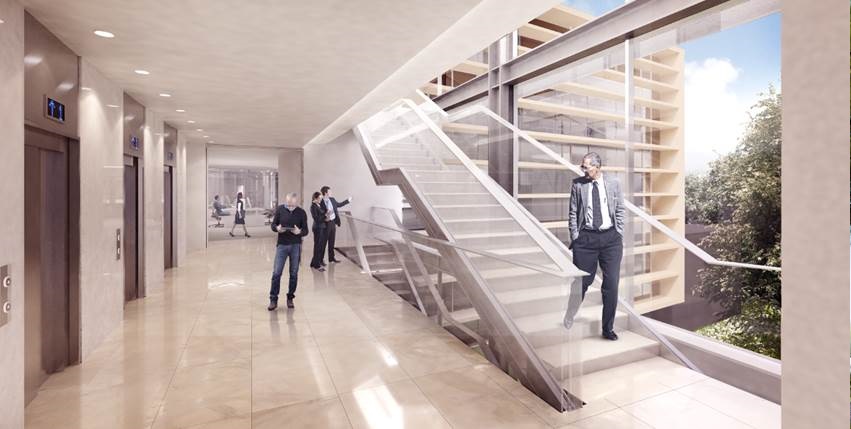EUIPO building - case study
In March 2017, EUIPO’s new building design was awarded the coveted Your BREEAM Award, at the BREEAM Awards ceremony in London. You can read Designing Buildings Wiki’s report about the ceremony here.
Designated the Eidificio EUIPO AA3, the building is currently under construction, and on completion will form part of the sustainable campus envisaged by EUIPO for its Alicante headquarters.
The EUIPO (European Union Intellectual Property Office) is a decentralised agency of the European Union, which manages the registration of the European Union trademark (EUTM) and the Registered Community Design (RCD).
The building obtained an ‘Exceptional’ ranking from BREEAM, the highest possible classification, which only 2% of all evaluated buildings achieve. It is in the process of obtaining the same classification for the post-construction phase.
The building is approximately 14,000 sq. m, and when compared with a traditionally constructed building of the same size, the design allows for a 71% reduction in CO2 emissions and a 67% reduction in energy.
The new AA3 Project benefits from the lessons learned during the BREEAM certification process of the AA2 building in 2015, and also from the 'In-Use' Certification of the AA1 building, which is currently in process.
Key features of the design include:
- Reduction in water consumption of 496.7 m3/year.
- Recycling or recovery of more than 95% of construction and demolition waste generated during the construction phase.
- Monitoring energy consumption with sub-meters in the main and secondary distribution boards, and by integrating them in the BMS system.
- Installation of energy-efficient equipment.
- Installation of lifts with an energy recovery system using a regenerative drive, that saves energy and feeds it back into the network with a positive charge.
- Monitoring water consumption via the BMS system.
- Re-use of greywater.
- Use of rainwater collected in storm tanks for watering plants.
- Implementation of low CO2 emissions technology.
- Maximum use of natural daylight.
- Use of cladding materials with low or ‘zero’ formaldehyde and VOC emissions.
- Use of environmentally-sustainable materials that have an Environmental Product Declaration (EPD).
- Use of recycled aggregates.
- Improvement of the biological quality of the site, with the creation of habitats with native plants that favour biodiversity.
- A strategy for eliminating existing invasive plants.
- The use of cooling gases with low CO2 emissions and installation of a leak-detecting system.
- Electricity supply obtained from renewable sources with zero emissions.
- A geothermal facility to cover heating and cooling needs.
- Installation of an adjustable outdoor lighting system to reduce night-time light pollution.
- Charging stations for electric vehicles, reserved car share parking spaces, and parking spaces for bicycles.
- Appointment of a commissioning manager.
- For the first three years of occupation, information will be compiled on occupant satisfaction, water and energy consumption, to check whether the building's performance meets the expected standards.
Project team:
- Client: European Union Intellectual Property Office (EUIPO)
- Architect: Carlos Rubio Carvajal, RUBIO Arquitectura
- BREEAM Assessor: Mercedes Cecilia García Ruiz, Servicios Ambientales Integrales del Norte, S.L.
- Contractor: FCC Construcción, S.A.
- Engineering: TYPSA
- Project Management Assistance: IDOM
- Site Supervision Team: GRUPOTEC
- Health and Safety Coordinator: PREMEA
- Quality control: TÜV ATISAE
Key facts:
- BREEAM Rating: Outstanding (Design Stage)
- Score: 90.85%
- Size: 13,993 m2
- BREEAM Version: BREEAM ES New Construction 2015
- Gross rentable area: 4,067.5 m2
- Plot surface : 14,032 m2
- Number of floors: Two below ground level and four above ground level
Images and content courtesy of EUIPO.
[edit] Find out more
[edit] Related articles on Designing Buildings Wiki
Featured articles and news
International Electrician Day, 10 June 2025
Celebrating the role of electrical engineers from André-Marie Amperè, today and for the future.
New guide for clients launched at Houses of Parliament
'There has never been a more important time for clients to step up and ...ask the right questions'
The impact of recycled slate tiles
Innovation across the decades.
EPC changes for existing buildings
Changes and their context as the new RdSAP methodology comes into use from 15 June.
Skills England publishes Sector skills needs assessments
Priority areas relating to the built environment highlighted and described in brief.
BSRIA HVAC Market Watch - May 2025 Edition
Heat Pump Market Outlook: Policy, Performance & Refrigerant Trends for 2025–2028.
Committing to EDI in construction with CIOB
Built Environment professional bodies deepen commitment to EDI with two new signatories: CIAT and CICES.
Government Grenfell progress report at a glance
Line by line recomendation overview, with links to more details.
An engaging and lively review of his professional life.
Sustainable heating for listed buildings
A problem that needs to be approached intelligently.
50th Golden anniversary ECA Edmundson apprentice award
Deadline for entries has been extended to Friday 27 June, so don't miss out!
CIAT at the London Festival of Architecture
Designing for Everyone: Breaking Barriers in Inclusive Architecture.
Mixed reactions to apprenticeship and skills reform 2025
A 'welcome shift' for some and a 'backwards step' for others.
Licensing construction in the UK
As the latest report and proposal to licence builders reaches Parliament.
Building Safety Alliance golden thread guidance
Extensive excel checklist of information with guidance document freely accessible.
Fair Payment Code and other payment initiatives
For fair and late payments, need to work together to add value.
Pre-planning delivery programmes and delay penalties
Proposed for housebuilders in government reform: Speeding Up Build Out.
High street health: converting a building for healthcare uses
The benefits of health centres acting as new anchor sites in the high street.


























